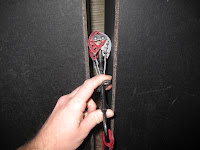 |
| trad gear with a smattering of cams |
The invention of cams was progressive in nature, but the first patent for a spring loaded camming device was filed by Greg Lowe in 1973. It wasn't until Ray Jardine took this idea, however, and developed his version in 1978 did the use of cams truly begin. Jardine called these original units "Friends". Although technology has developed with cams to make them more user friendly, versatile, or specialized to a particular type of crack, modern camming units work much the same as the original Friends.
Today there are several manufacturers that make their own version of the SLCD, especially Wild Country, Black Diamond, Metolius and a few others. Most companies have several different types of cams that serve different purposes, i.e. cams that are wider with more surface contact to spread the load on softer stone, or cams that have flexible stems for awkward and horizontal placements. All cams, however, function based on the same basic principles of physics.
II. CAM USE 101
Properly placed with the apex of the rounded lobes oriented at 90 degree angles from the orientation of the stem (see figure a), cams function by the action of the stem pulling on the rounded lobes of the cam which rotate and become locked with opposing outward force. The outward force generated is two times the downward force, which generates enough friction when properly placed to protect even a very nasty fall. A perfect cam placement is very solid but relies on a few key components.
The first key element is the rock itself. Not even a perfect placement is worth anything if the rock isn't strong enough to withstand the high forces generated in big fall. For this reason, avoid detached flakes and exceptionally brittle sandstone or other soft rock types.
 |
| (figure a.) a cam in a mock crack with near perfect retraction |
The third key element is the correct sizing and placement of the cam. Ideal placement is when the cam is between 50 and 90 percent retracted. Some cams have indicators showing you when a cam is at its ideal angle. It is also important to place the cam deep enough without making it hard to retrieve as well as orienting the stem in the anticipated angle of a possible fall. Keep in mind, this is only a very basic overview and mastering all of this takes many hours of practice.
III. DIFFERENT TYPES OF CAMS
As mentioned above, there are many different types of cams on the market today and knowing which is best depends a lot on you. At a basic level, modern cams consist of a stem and a set of either 3 or 4 lobes. Three-lobed units have a narrower head and can therefore fit in small points in the crack. Four-lobed units have more surface area and therefore have more holding power. It is also possible to buy offset cams where the lobes are wider on one side than the other. These specialty cams are the best way to protect flaring cracks where regular cams might not suffice. Another specialty variation is the flexible stem which allows the cam to better redirect forces when protecting horizontal cracks and other misshapen features.
 |
| A comparison of common sizes from large (Black Diamond Camalot C4 size 5), medium (Black Diamond Camalot C4 size 1), and very small (Black Fixe Hardware Alien) |
 |
| A comparison of the head width between a 3-lobed and 4-lobed cam of similar size |
Camalots are a modern trad climbers best friend. They are the technological development that allow us to climb parallel sided cracks with ease and confidence as well as allow us to climb "clean" without using rock-damaging metal gear like pitons and nails. Learning how to properly use cams is a crucial part of today's trad climbing world. While all cams are the same at their core, there is a lot of variation between different companies as well as different models of cam within the same company. Make sure to do plenty of research, bearing in mind your own climbing ability and style before investing in a set of cams to fill your rack.
V. FURTHER RESOURCES
When considering what kind of cam you want to add to your rack, it is important to do your research. Here are a few sources to further your understand of SLCDs and what is available on the market:
Rock Climbing Anchors by Craig Leubben- On Amazon.com
Black Diamond's official page covering rock protection
Wild Country's official page covering their rock protection
Metolius's official page

No comments:
Post a Comment